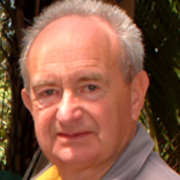
John Earnshaw
John Earnshaw's life was defined by a love of cameras and aeroplanes, a combination he was well aware could resuit in dangeorus situations.
Though he spent almost four decades in New Zealand, Earnshaw was born in the UK in 1939. As a teen he spent time in India, where his father was an aircraft engineer. John learnt to fly Tiger Moths and gliders, and was a keen photographer. After a stint in the merchant navy (one of several parallels with fellow emigre Steve Locker-Lampson), he joined a commercials company in London. Colleagues soon invited him to be a camera assistant on their next movie.
Earnshaw went on to work in the camera department on movies directed by Stanley Kubrick (2001: A Space Odyssey) and Roman Polanski (Cul-de-sac). He shot footage on promotional films for Shell Oil and the British Armed Forces.
Earnshaw would do his share of movies involving low flying aircraft — a topic for which he developed a healthy respect and abiding interest. Aviation photography, as he once said, “is not without it's risks”, as he discovered while clapper loading on probably his earliest feature, 1966 George Peppard movie The Blue Max.
One scene required the pilot of a replica World War I Fokker to fly above a row of trees, then quickly level off, close to the ground. Watching the plane approach, Earnshaw swiftly ducked after noticing that the aircraft's wheels were lower than the camera. One wheel ripped the camera motor from his hand; legendary cinematographer Douglas Slocombe and cameraman Chic Waterson were injured. In 1970 Earnshaw's friend John Jordan, a colleague from movie Battle of Britain, was capturing aerial footage for Catch 22, when he fell to his death over the Gulf of Mexico.
In 1975 Earnshaw migrated to New Zealand, establishing himself as a director of photography on TV commercials and promotional films. It is said he worked on 500 plus titles, including ads for major clients like Schweppes, Air New Zealand, Qantas, Datsun and the NZ Dairy Board.
He soon met commercials director Roger Donaldson. Earnshaw was camera assistant when Donaldson got the chance to make Winners and Losers (1976), a breakthrough series of dramas for television. In the same period he shot helicopter footage for singer John Denver (who later died in a plane crash).
In 1977 newbie director David Blyth tapped Earnshaw to shoot his first feature, Angel Mine. The results of their collaboration included arresting images of a naked woman sitting on a beachside toilet, and a surrealistic sequence involving a windswept clothes-line. Shot for just $40,000, the film was an ambitious mixture of satire, fantasy and the avant garde. Blyth has fond memories of Earnshaw's store of tales and his Cockney rhyming slang, including christening a light flare a lord mayor. Not so pleasant was sending the 16mm footage to be processed in Belgium, meaning the results couldn't be checked until weeks after the shoot.
The two tripped from cult movie to period drama with follow-up A Woman of Good Character (later expanded into It's Lizzie to Those Close). Sarah Peirse won a Feltex Award as a British servant facing tough times on a sheep farm (shot in the hills above Queenstown). Earnshaw also helped out on the shoots for Utu and music festival memoir Nambassa.
John Earnshaw died of cancer early on 3 March 2014. He left behind him an unrealised dream: documentary The Search for Boeing One. Earnshaw spent over a decade researching the first two airplanes designed by aviation pioneer William Boeing, which disappeared in the 1920s after being relocated to New Zealand. Concluding they were in military tunnels below North Head in Auckland, Earnshaw won a salvage contract to confirm it. But after extended legal battles with the government over project ownership and site access, the crown were awarded $80,000 in court costs against him in 2003. He accused public servants of duplicity and antipathy. Earlier Earnshaw was interviewed for this 1992 documentary about the tunnels. Jon Smyth, who took over Earnshaw's project, hopes to develop the saga as both a film and a book.
Sources include
Special thanks to David Blyth for his help
with this profile
John Earnshaw, ‘Cinema of the Skies’ (Interview) - New Zealand Aviation News, December 2008/Jan 2009, page 29 (Volume 31, Number 10)
The Hijack of Boeing One website. Accessed 16 March 2016
The Hijack of Boeing One Facebook page. Accessed 16 March 2016